#more traditional African clothes
Explore tagged Tumblr posts
Note
I just want you to know that I will always love and cherish you for the art you do
Especially when you draw Leona in traditional African (Yoruba) clothing. It brings me joy and I need to know how tf Vil wrapped his hair up like that because I could never
Dffgytyrefgy I’m gonna hide into the tiniest hole I can find but omg thank youuu ; ;
Also, thank you for reminding me to draw more Yoruba!Leona 🙏
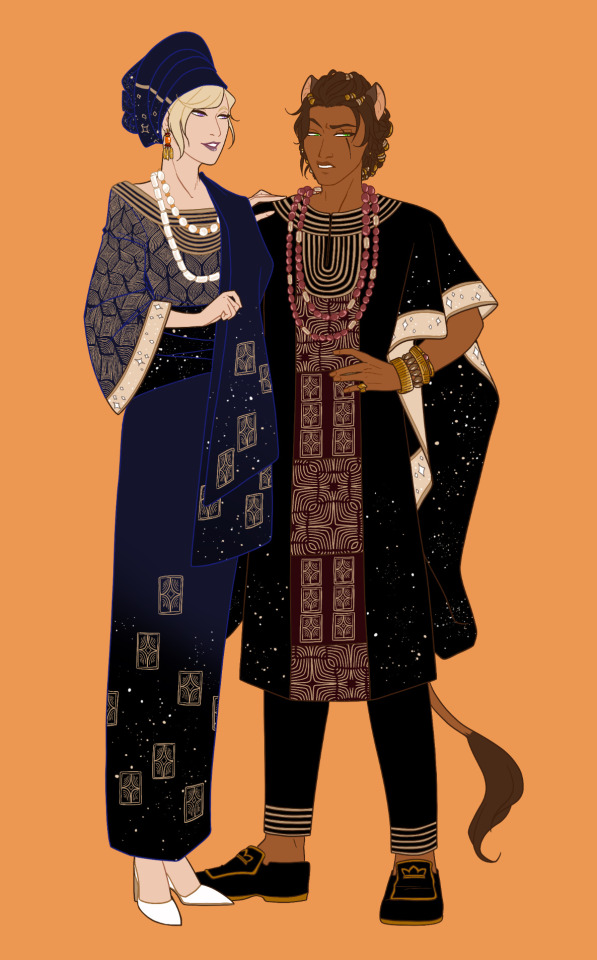
Took the advantage to draw them in their funeral attire in Crownless then 🎵 These clothes are so nice to draw x3
And don’t be fooled by Vil, he got help from maids. Though, I’m sure he could be more than persistent to learn how to tie a gele by himself.
#answer#twisted wonderland#vil schoenheit#leona kingscholar#crownless#I made my own crappy map of sunset savanna to put various african countries into#if I had more time I would love to make a post to talk about it damn#and exchange!#it was a bit of hell to just find the word gele and aso oke srly#anyway#[fist slapping the table]#more traditional African clothes#such various and gorgeous fashion damn
496 notes
·
View notes
Text
two movies that play with history in costuming in ways that make Brain Go Brrrr for me:
Jingle Jangle, A Christmas Journey (2020). the actual plot was very much a "this is fine but I'm not the intended audience and I didn't watch it as a child, so it will never have the nostalgia factor and it doesn't particularly compel me as an adult. and that's okay!" situation
but the COSTUMES. oh my god. Cheyney McKnight calls this "Afro-Victorian," and they did it in such an amazing way. one part that struck me is the way the clothes change over time- they didn't have to start it with 1860s-inspired fashions and then make the 30 Years Later timeskip clearly 1890s. it's a fantasy land; people would have forgiven them. but they DID and it's SO COOL

beginning of the movie. the hoops! the little perched hats! this is clearly like 1865, but it works in a lot of both fantastical twists and colors and patterns inspired by various African cloth-dyeing traditions

main character's adult daughter, after the timeskip. puffed sleeves! menswear-inspired tailoring! this is clearly Fantasy 1890s!

main character's granddaughter and her friends post-timeskip. honestly, I say African-inspired textile colors and prints, but some of these would definitely not be out of place in classic European Victorian fashion. mostly the plaid on the white girl here. appropriate skirt lengths for little girls! Cute BootsTM! hats on 99% of the female characters in this shot!
the other is The Favourite (2018)
early 18th century is severely underrepresented in film. the 1690s-1710s were gorgeous and I will die on this hill. plus the way they play around with laser-cut trim and exaggerated hair and makeup is heightening the period look, not watering it down to suit modern sensibilities

Queen Anne and her lover are doing something here; I forget what. I liked the movie, but it wasn't a- pardon the pun -favorite

would she have been wearing full-on masc clothing to shoot? probably not. is it reasonably accurate masc clothing for the era, but Stylized? yes! Also This Is Hot so I'm not complaining. maybe I'd be more into butches if they wore historical menswear...? anyway I digress

holy Tim Burton wet dream I love it so much
do I think Black Panther deserved to win the Oscar that year because the designer had to create a whole visually cohesive clothing culture from scratch? yes. do I still love the costumes in this movie? YES.
so like. it's not that I require 100% accuracy! I just like movies to be having a conversation with history rather than shouting over it, if that makes sense. (also avoiding my specific pet peeves- just be normal about corsets and put women's hair up/add hats where there should be hats. please?)
787 notes
·
View notes
Text
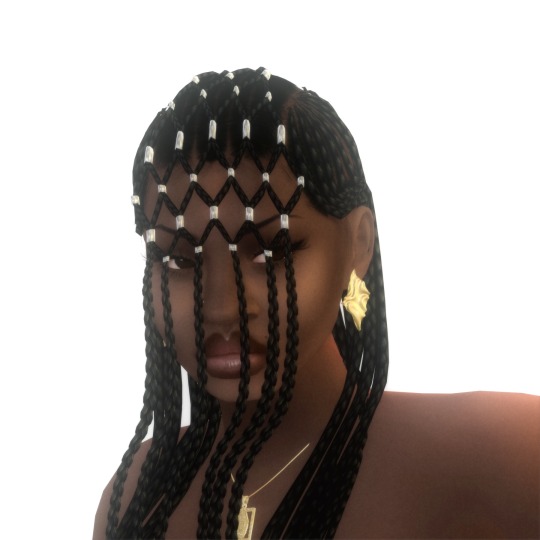
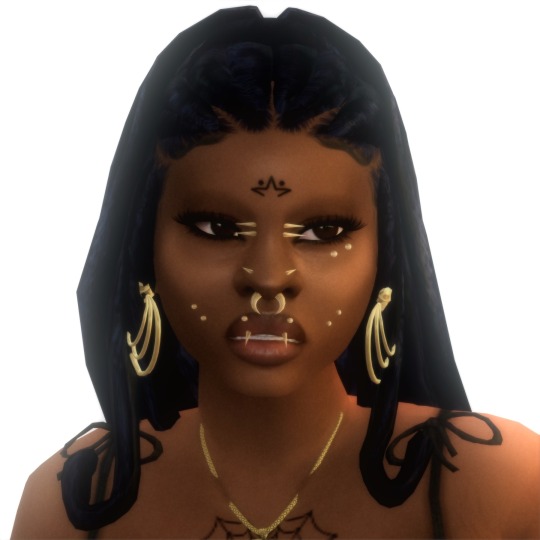

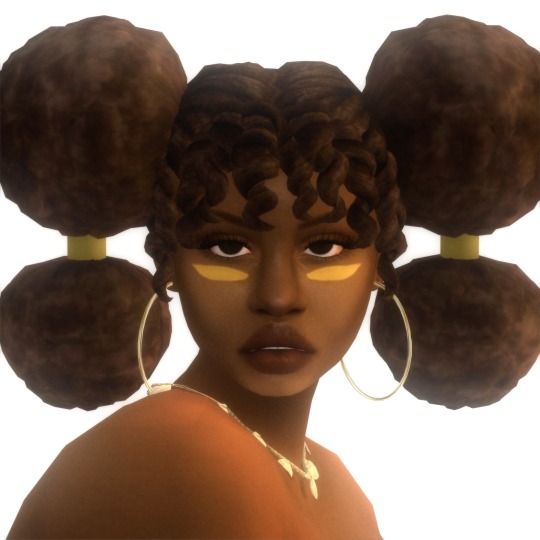
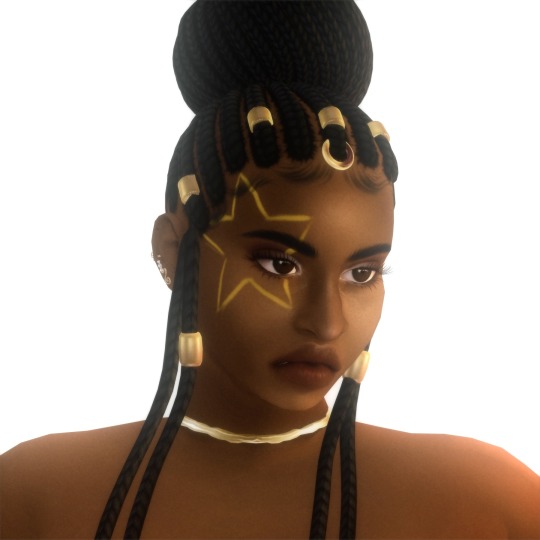
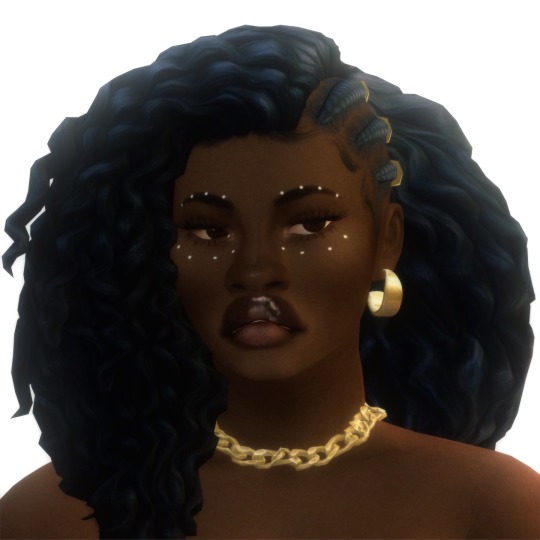
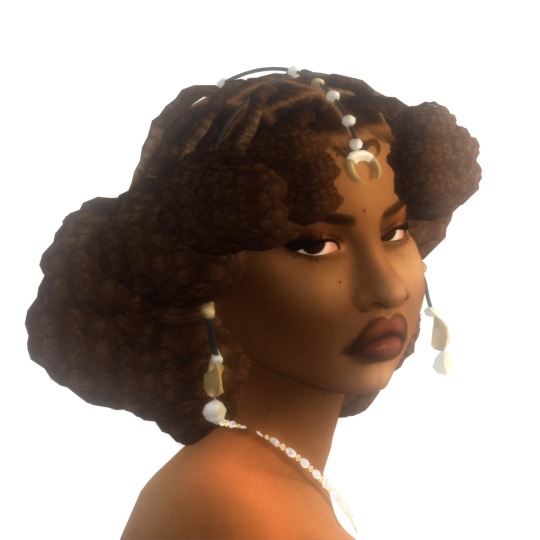

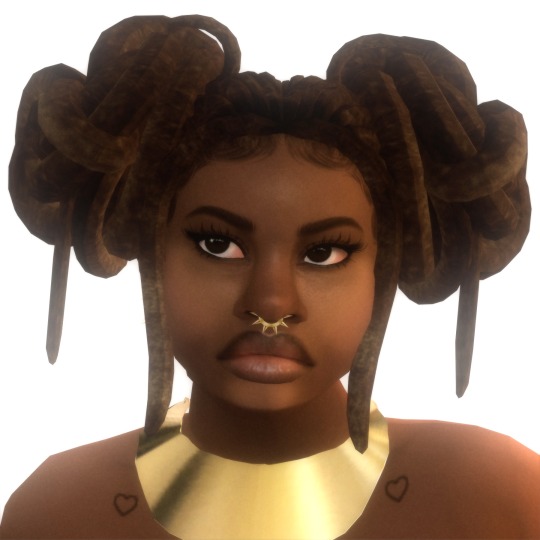
afrofuturism🪐
☆ one ~ solange hair by darknightt (tsr warning) ☆ two ~ loretta hair by @simtric ☆ three ~ bahati braids by @sheabuttyr ☆ four ~ isonoe hair by octetsica ☆ five ~ binah braids by @sheabuttyr ☆ six ~ cornrows & curls hair by @leeleesims1 ☆ seven ~ indie hair by @sashima ☆ eight ~ loc petals by @shespeakssimlish ☆ nine ~ mnemosyne hair by octetsica ☆
mini dedication essay to black simmers and ts4 creators below! pls read if you have the chance! <3
this edit is a small homage to afrofuturism and the various unique black hairstyles (and especially the black creators of most of these hairs) that i have downloaded and admired over the years! some of these are old and some of these are new.
to me, afrofuturism means constantly honoring/reclaiming/challenging the past while constantly creating/dreaming of a better society/world/future. a society/world/future that embraces and empowers all of our differences, ingenuity, aspirations, and unique lived/cultural experiences. a society/world/future that does not limit us through the various systems of marginalization and oppression (racism, homophobia, transphobia, fatphobia, sexism, xenophobia, ableism, classism, colorism, etc.) that often affects how we, as black people, live today.
blackness is so diverse and intricate yet it's always been a struggle to find my culture within a game that's known for being so limiting, bland, and extremely eurocentric when it comes to hairstyles, clothing, food traditions/events, etc. black simmers have always had to figure out how to make this game more inclusive and make it resemble either more like how our ancestors lived, how our current lives are, or how we would want our lives (and even our children's lives) to look like in the future no matter how dystopian the real world look and feel now. fortunately, these hairs and their uniqueness bring a huge sense of culture and style to this game. they have always inspired me and made me feel extremely proud to a part of the lovely african diaspora (and the ever-growing black simmer community).
in a way, being a black simmer and cc creator usually means that we are often digitally creating our own worlds as afrofuturists to varying degrees (whether we know it or not) every time we open our game, make our sims, make houses, and/or make black cultural cc. also, now i know that cc making is not easy to do and is extremely time-consuming so this post is also just me giving all black cc creators especially those who create for free their well-deserved flowers! here are some other black cc creators who created cc that have greatly impacted my game since i first started playing sims 4: @/leeleesims1 @/simtric @/hi-land @/yuyulie @/sims4bradshaw @/ebonixsims @/xmiramira @/sheabuttyr @/qwertysims @/oplerims @/sleepingsims @/shespeakssimlish and so many more im forgetting probably (im too shy rn to tag ppl but i greatly appreciate y’all fr i hope y’all telepathically get this message somehow 😭).
last but not least, i am hoping that this inspires somebody to keep creating or start creating regardless of what they think their skill level is! somebody will absolutely fall in love with your work and/or your art/work will 100% change someone's game forever <333
#ts4#sims 4#the sims 4#black simblr#black simmer#ts4 edit#🪐#🪐 black hair#soleil jones#xolani souza de oliveira#angela evans#leona morrison#chantelle diang#ayesha solomon#nylah rivers#nykhor chantelle diang#dove adeyemi#something to end black history month with!#i really hope my essay make sense 😭😭😭#i planned to this last year but hated the pictures i took so i scraped it and redid it#i couldn’t thank enough to all the black cc creators before me and hope to help/inspire new black cc creators 🙏🏾#this is also kinda the updated version of my for the culture post…i made sure to include some familiar (but updated) faces 😭☝🏾💗🙈
2K notes
·
View notes
Text

Chikezie, 21
“My shirt is Lucmatton, skirt AlkebulanLifestyle, boots Burlington, headpiece traditional Nigerian, and choker traditional Kenyan. I am Nigerian American and I love traditional African clothing and adornments. I am passionate about decolonization and I try to practice decolonization through fashion. I grew with Nigerian parents but unfortunately I was not taught my language or culture as a result of being born and raised in the United States. It wasn’t until I was about 17 that I started to become passionate about Africa, learning more about where I come from, and working to help those on the continent. I find myself drawn to patterns and prints and I definitely do not shy away from color. I make some of my clothes (not pictured here) and it’s definitely a fun hobby of mine. I hope to motivate other people, no matter their background to wear their own traditional culture as there is so much artistic traditional culture around the world and it’s important we do not forget where we come from.”
Apr 30, 2024 ∙ Tribeca
#nyc looks#street style#street fashion#new york#style#outfit#fashion#nigerian#african style#african fashion
539 notes
·
View notes
Text
So it is with Florence Hines, a Black singer and drag king who got her start on the stage sometime around 1891, when she began to receive particular notice for her performances with Sam T. Jack’s Creole Burlesque. When the show came to Paterson, NJ, on November 23, 1891, “hundreds were turned away from the doorway” before the Creole Burlesque was even scheduled to take the stage, according to the Paterson Daily Caller. In their review, they called out Hines in particular for being an “excellent male impersonator.” The Creole Burlesque was a standard minstrel show, featuring all Black performers, led by a white manager, giving skits, songs, and scenes that featured standard variety acts (everything from clog dancing to drag) set in a pre-Civil War Southern plantation fantasy. But within a few years, Sam T. Jack would launch The Creole Show, an important milestone in Black performance in America. For the first time, an all-Black revue was presented as a modern, staged performance — not as an “authentic” recreation of Black life. According to Whiting Up, a history of white face entertainment by Black theater historian Marvin McAllister, The Creole Show was “a major outlet for Black artists interested in… developing a comedic tradition that was racially grounded but not riddled with stereotyping.” In another important departure from tradition, instead of hiring a man to play the traditional lead role of interlocutor or master of ceremonies, Sam T. Jack hired Florence Hines. As a drag king, Hines performed a routine that made mock of the “dandy” — flashy, modern, young men who drank and dated openly, and wore the latest clothes. One of her most famous numbers was “Hi Waiter! A Dozen More Bottles,” whose first verse went: Lovely woman was made to be loved, To be fondled and courted and kissed; And the fellows who’ve never made love to a girl, Well they don’t know what fun they have missed. I’m a fellow, who’s up on the times, Just the boy for a lark or a spree There’s a chap that’s dead stuck on women and wine, You can bet your old boots that it’s me. Many white drag kings of the day also performed this song, and similar dandy characters. For these performers, the dandy was a way to needle the men in the audience. But for Black performers, taking on a dandy role was also a way of resisting degraded depictions of Black people that were common on stage at the time. As Kathleen B. Casey wrote in The Prettiest Girl on the Stage is a Man, “when worn by a Black performer, the tuxedo with tails, cane, cape and a top hat countered the image of the ragged, shoeless plantation slave.” Thus, Hines made a natural choice for a show that wanted to show an entirely new kind of Black performance. By 1904, The Indianapolis Freeman would report that Hines “commanded the largest salary paid to a colored female performer.” In their book, Out of Sight: The Rise of African American Popular Music, 1889-1895, Lynn Abott and Doug Seroff wrote that “Hines’s male impersonations provided the standard against which African American comediennes were compared for decades.”
343 notes
·
View notes
Text
Kwanzaa:

Kwanzaa, an annual holiday celebrated primarily in the United States from December 26 to January 1, emphasizes the importance of pan-African family and social values. It was devised in 1966 by Maulana Karenga, Inspired by Africa’s harvest celebrations, he decided to develop a nonreligious holiday that would stress the importance of family and community while giving African Americans an opportunity to explore their African identities. Kwanzaa arose from the black nationalist movement of the 1960s and was created to help African Americans reconnect with their African cultural and historical heritage. The holiday honors African American people, their struggles in the United States, their heritage, and their culture. Kwanzaa's practices and symbolism are deeply rooted in African traditions and emphasize community, family, and cultural pride. It's a time for reflection, celebration, and the nurturing of cultural identity within the African American community.
Kwanzaa is a blend of various African cultures, reflecting the experience of many African Americans who cannot trace their exact origins; thus, it is not specific to any one African culture or region. The inclusiveness of Kwanzaa allows for a broader celebration of African heritage and identity.
Karenga created Kwanzaa during the aftermath of the Watts riots as a non-Christian, specifically African-American, holiday. His goal was to give black people an alternative to Christmas and an opportunity to celebrate themselves and their history, rather than imitating the practices of the dominant society. The name Kwanzaa derives from the Swahili phrase "matunda ya kwanza," meaning "first fruits," and is based on African harvest festival traditions from various parts of West and Southeast Africa. The holiday was first celebrated in 1966.
Each day of Kwanzaa is dedicated to one of the seven principles (Nguzo Saba), which are central values of African culture that contribute to building and reinforcing community among African Americans. These principles include Umoja (Unity), Kujichagulia (Self-Determination), Ujima (Collective Work and Responsibility), Ujamaa (Cooperative Economics), Nia (Purpose), Kuumba (Creativity), and Imani (Faith). Each family celebrates Kwanzaa in its own way, but Celebrations often include songs, dances, African drums, storytelling, poetry readings, and a large traditional meal. The holiday concludes with a communal feast called Karamu, usually held on the sixth day.
Kwanzaa is more than just a celebration; it's a spiritual journey to heal, explore, and learn from African heritage. The holiday emphasizes the importance of community and the role of children, who are considered seed bearers of cultural values and practices for the next generation. Kwanzaa is not just a holiday; it's a period of introspection and celebration of African-American identity and culture, allowing for a deeper understanding and appreciation of ancestral roots. This celebration is a testament to the resilience and enduring spirit of the African-American community.
"Kwanzaa," Encyclopaedia Britannica, last modified December 23, 2023, https://www.britannica.com/topic/Kwanzaa.
"Kwanzaa - Meaning, Candles & Principles," HISTORY, accessed December 25, 2023, https://www.history.com/topics/holidays/kwanzaa-history.
"Kwanzaa," Wikipedia, last modified December 25, 2023, https://en.wikipedia.org/wiki/Kwanzaa.
"Kwanzaa," National Museum of African American History and Culture, accessed December 25, 2023, https://nmaahc.si.edu/explore/stories/kwanzaa.
"The First Kwanzaa," HISTORY.com, accessed December 25, 2023, https://www.history.com/this-day-in-history/the-first-kwanzaa.
My Daily Kwanzaa, blog, accessed December 25, 2023, https://mydailykwanzaa.wordpress.com.
Maulana Karenga, Kwanzaa: A Celebration of Family, Community and Culture (Los Angeles, CA: University of Sankore Press, 1998), ISBN 0-943412-21-8.
"Kente Cloth," African Journey, Project Exploration, accessed December 25, 2023, https://projectexploration.org.
Expert Village, "Kwanzaa Traditions & Customs: Kwanzaa Symbols," YouTube video, accessed December 25, 2023, [Link to the specific YouTube video]. (Note: The exact URL for the YouTube video is needed for a complete citation).
"Official Kwanzaa Website," accessed December 25, 2023, https://www.officialkwanzaawebsite.org/index.html.
Michelle, Lavanda. "Let's Talk Kwanzaa: Unwrapping the Good Vibes." Lavanda Michelle, December 13, 2023. https://lavandamichelle.com/2023/12/13/lets-talk-kwanzaa-unwrapping-the-good-vibes/.
901 notes
·
View notes
Text

30 Ways Modern-Day Africans Still Exhibit a Colonial Mindset: A Garveyite Analysis
Marcus Garvey’s Pan-Africanist philosophy emphasized self-reliance, cultural pride, and the rejection of colonial influence. However, many Africans today still exhibit behaviours and attitudes rooted in a colonial mindset. Below are 30 examples, explained and analyzed in depth, from a Garveyite perspective:
1-10: Cultural Influence and Identity
1. Preference for European Standards of Beauty
Example: Many Africans prioritize lighter skin, straight hair, and European features over natural Black aesthetics.
Analysis: Skin-lightening creams and the global embrace of Eurocentric beauty ideals reflect internalized inferiority and rejection of African identity.
2. Disdain for African Languages
Example: African children are often discouraged from speaking native languages in favour of English, French, or Portuguese.
Analysis: Linguistic erasure ensures dependency on colonial languages for governance, education, and international relations.
3. Glorification of Western Education
Example: Degrees from European or North American universities are valued more than African ones.
Analysis: This reinforces the notion that African intellectual systems are inferior, perpetuating brain drain and dependency.
4. Adoption of Western Names
Example: Africans often give their children Western names instead of traditional African ones.
Analysis: This signifies a rejection of African heritage in favour of aligning with Western norms.
5. Colonial Religious Practices
Example: Christianity and Islam dominate African spiritual practices, while indigenous beliefs are demonized.
Analysis: Religion was used as a colonial tool to pacify and control, and its dominance reflects ongoing psychological colonization.
6. Rejection of African Fashion
Example: Western suits and dresses are deemed more "professional" than African attire in workplaces.
Analysis: Clothing reflects identity, and the preference for Western styles reinforces the idea that African traditions are primitive.
7. Accent Bias
Example: Africans with European or American accents are viewed as more intelligent or credible.
Analysis: This bias reflects internalized colonial superiority.
8. Neglect of African History
Example: African curricula prioritize European history over African empires like Mali, Songhai, or Great Zimbabwe.
Analysis: This erasure perpetuates ignorance about Africa’s rich heritage and contributions to civilization.
9. Worship of Western Entertainment
Example: Hollywood and European music dominate African media, sidelining local industries.
Analysis: This promotes cultural dependency and undervalues African creativity.
10. Desire to Migrate to the West
Example: Many Africans dream of emigrating to Europe or the U.S. for a "better life."
Analysis: This mindset undermines the potential of building strong nations on the continent.
11-20: Political and Economic Dependence
11. Reliance on Foreign Aid
Example: African governments often depend on Western aid for development projects.
Analysis: This fosters dependency and allows Western nations to control African policies.
12. Colonial Borders
Example: African nations still adhere to arbitrary colonial borders that divide ethnic groups.
Analysis: The refusal to renegotiate these borders reflects a lack of sovereignty and Pan-African unity.
13. Imitation of Western Governance
Example: African governments replicate Western political systems, often failing to adapt them to local contexts.
Analysis: Blind imitation undermines the development of systems rooted in African traditions and needs.
14. Dependence on Western Currencies
Example: The CFA franc, used by West and Central African nations, is controlled by France.
Analysis: This reflects continued economic colonization and inhibits financial independence.
15. Exploitation of Resources by Foreign Corporations
Example: Multinational companies exploit Africa's oil, minerals, and agriculture with little reinvestment.
Analysis: Africans prioritize Western partnerships over local ownership and control.
16. Outsourcing Security to Foreign Powers
Example: French troops stationed in Africa under the guise of fighting terrorism.
Analysis: This reinforces the narrative that Africans can not secure their own nations.
17. Preference for Imported Goods
Example: Imported clothing, food, and technology are seen as superior to local products.
Analysis: This devalues African production and stifles economic growth.
18. Neocolonial Debt Traps
Example: African nations take loans from institutions like the IMF, leading to perpetual debt.
Analysis: These loans come with conditions that undermine sovereignty.
19. Overdependence on Western Technologies
Example: Africa imports most of its technology rather than building local industries.
Analysis: This dependency stifles innovation and economic independence.
20. Election Interference by Western Powers
Example: Western nations influence African elections through funding or propaganda.
Analysis: This undermines democratic processes and reinforces external control.
21-30: Social and Psychological Patterns
21. Black Elitism
Example: Africans educated in the West often look down on those educated locally.
Analysis: This creates divisions within African societies and perpetuates classism.
22. Hostility Toward Pan-Africanism
Example: Resistance to efforts to unify Africa economically or politically.
Analysis: Colonial powers instilled fear of unity to prevent collective strength.
23. Undervaluing African Labour
Example: African workers are underpaid while foreign workers are overpaid for similar roles.
Analysis: This reflects an internalized belief in the superiority of non-African expertise.
24. Neglect of Local Agriculture
Example: African nations import staple foods like rice despite fertile lands.
Analysis: This prioritizes foreign economies over local food sovereignty.
25. Demonization of Traditional Medicine
Example: Preference for Western pharmaceuticals over indigenous remedies.
Analysis: This reflects distrust in African innovation and healing systems.
26. Preference for Colonial Languages in Art and Literature
Example: Writers and artists creating works in English or French to gain Western recognition.
Analysis: This marginalizes African languages and creativity.
27. Inferiority Complex Toward Western Nations
Example: Africans praise Western infrastructure while criticizing their own.
Analysis: This self-perception hinders the belief in African potential.
28. Overlooking the African Diaspora
Example: Africans often ignore the struggles and contributions of African Americans, Caribbeans, etc.
Analysis: Colonial divisions still separate the global African community.
29. Dependence on Colonial Education Systems
Example: African nations still use colonial curricula with minimal African content.
Analysis: Education is a tool of control, and this reflects ongoing intellectual colonization.
30. Hostility Toward Repatriation
Example: Africans discouraging descendants of the enslaved from returning to Africa.
Analysis: This reflects colonial teachings that Africa is undesirable or unworthy.
Garveyite Call to Action:
Marcus Garvey warned against mental colonization and called for:
Reclaiming African identity: Embrace African languages, cultures, and traditions.
Economic independence: Build industries, control resources, and support local economies.
Pan-African unity: Foster solidarity among Africans worldwide.
Rejection of Western validation: Recognize that Africa’s greatness does not depend on foreign approval.
“Liberate the minds of men, and ultimately, you will liberate the bodies of men.” – Marcus Garvey
#Neocolonialism#black people#black history#blacktumblr#black#black tumblr#pan africanism#black conscious#africa#africa history#self reliance#Reclaim Africa#African Liberation#black liberation#garveyite#marcus garvey#garveyism#Colonial Mindset#colonization#african diaspora#black diaspora
115 notes
·
View notes
Text

Expedition Pilgrims
Sha Wujing (435cm): His outfit is mostly inspired by Mongolian clothes since he's found in the Gobi desert stretch of the journey. His bangles are made of fossil bone, and he can use the waist cloth as a headwrap during adverse weather. His markings are inspired by African Lungfish and Mudfish fins, as they are species that exist somewhere between water and dry air. The beasts on his knees are an extension of him, and he can see and speak through them as needed. His beard and long hair can have Ghibli physics depending on his mood and emotions. Zhu Wuneng (~300cm): Inspired by Northern Tibetan clothes, as that's the region the group recruits him. Traditional clothes tend to have way more accessories and golden details so I had to simplify a bit. His features are a mix of wild boars and Indonesian babirusa, with the iconic bristles on his head. I leaned on ceremonial Tibetan swords and necklace beads for the decorations on his rake. His vest can be closed, he just prefers not to most of the time. Sun Wukong (125cm): I've already commented on his design over here, but I'll elaborate that the yellow shirt is the one he gained from Tripitaka soon after he was released, while the pants and red half-robe were the garments he was given by Guan Yin. The hoops on his feet and purple beads were reacquired back in Huaguoshan when he first fled the pilgrimage, heading to his family instead of Ao Guang's palace. (A-ma and Jinju gave them to him so he'll always have something to home to remember them by, as well as where he first started, as the beads were gained during his lessons with Subodhi.) Tripitaka (163cm): This is but one of his many outfits since travel can be rough on clothes, and even more so when you get kidnapped by demons and thrown off your horse all the time. He wears the usual orange monk robes, with some kind of travel clothes over them. He gains some fur boots from Boquin for cold weather but usually prefers sandals most of the time. He seldom uses the cassock and crown he received from Guan Yin, save for when he pays respects to temples and holy sites, but the staff is a constant companion. Ao Lie (167cm, 130cm at the shoulder as horse): Being effectively in exile until the journey is complete, he wears less fancy clothes than he usually would as a prince, but his status still shows. I tried to balance more casual hanfu of the era with some armor parts, like the waist guard and armored boots. He was given the skill to shapeshift into a horse by Guan Yin when she commanded him to wait for the chosen pilgrim monk, so he can shift at will, but preferably when the tack has been taken off. Speaking of, tack is lost and replaced multiple times during the journey, so I didn't depict any specific one.
my Expedition AU designs and heights for the five lads, ive spent so much time on this its not even funny lololol but hey it's done!! i'm free!!
#journey to the west#jttw#xiyouji#jttw au#jttw fanart#expedition to the west au#Sun clan au#bell dragon art#sun wukong#monkey king#sha wujing#zhu bajie#tang sanzang#tang xuanzang#tripitaka#bai longma#ao lie
1K notes
·
View notes
Text
What is the real world equivalent of Afterglow/Sunset Savanna?
At first, I thought (hoped, lol) it was South Africa, but I'm not too sure
One of the languages sung in the original Lion King, in fact, the opening line of the movie is Zulu! ("Nants ingonyama bagithi Baba," which means "Here comes a lion, father.") Zulu is one of South Africa's 12 official languages.
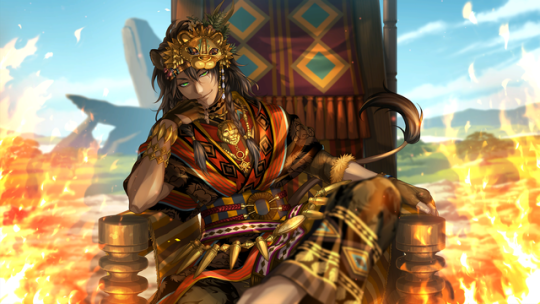
The diamond patterns and general style of Leona's clothing are quite similar to that of the Swahili people, although diamond patterns can also be found in traditional Zulu clothing and beadwork.
Swahili, too, is one of the languages spoken in The Lion King and is mainly spoken in countries along the East African Coast outside of South Africa.
However, looking at the background in one of the screens in the actual game (and a background in the event iirc) you can find proteas in the right corner

(Ignore how I circled the hidden mickey lol). But there on the right are pincushion proteas, as well as king, queen, and prince proteas. These fynbos flowers are native to South Africa, specifically the Cape Floral region. They're also South Africa's national flower.

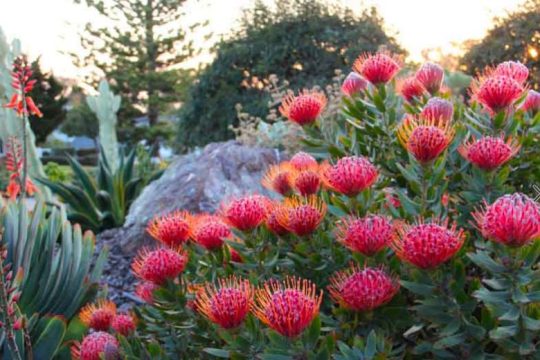


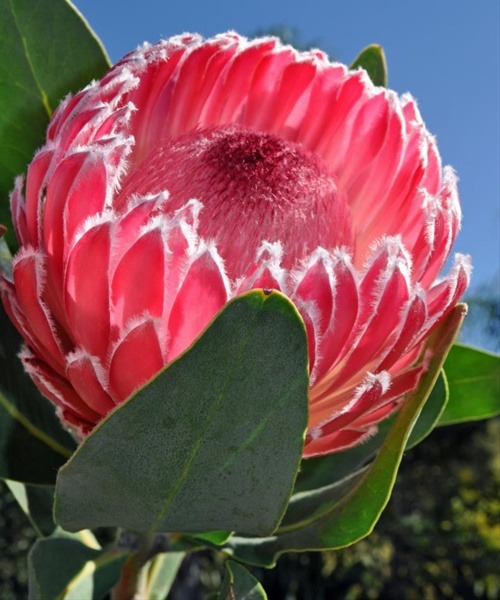
Of course, this is nowhere near the East African coast.
The background also reminds me of fond memories of going to various craft markets or passing by people selling their wares on the side of the road. Woodwork, pottery, beadwork, clothes, baskets, etc were always so fun and beautiful to look at, and you can see those things in the background too.
I don't live anywhere near the East African Cost, I live in the cape, so I'm not sure what local town markets look like there.
So from what I've seen, Yana probably took inspiration from the cultures and countries the two of the three languages in The Lion King, so it's a murky mix of more than one place (which is unfortunate since they're so distinct).
I still like to think it's the twst version of South Africa, though, since we're quite well known for having many unique cultures, languages and traditions in one place, and the Sunset Savanna seems similar.
#quinn quips#twisted wonderland#leona kingscholar#savanaclaw#cloudcalling on the savanna#twst analysis
154 notes
·
View notes
Text
While I’m on my ✨Race in Thedas✨ rant let me just explain why the blending of Dalish and City Elves bothers me personally.
As I said previously, I’m mixed. I’m specifically black in the ‘descendants of enslaved people’ way. I grew up in a predominantly white area but finished out highschool in a diverse school with a high number of first gen African immigrants.
(I promise this is pertinent) My relationship with race has always been complex. I benefit from a proximity to whiteness due to being mixed, but I of course still experienced rampant racism and an identity crisis.
In elementary school we had to do a yearly genealogy project. In some ways, mine was easier than the few other black kids in my class. While their families were nearly untraceable past 2-3 generations, I could just focus my effort on my mother’s side. Though, I faced ridicule because OBVIOUSLY I wasn’t white, so obviously I couldn’t be German. While I may have shared DNA, I felt much less experientially connected to the ‘family tree’ I did my reports on because their lives could look nothing like mine. They walked through world without the color of their skin first. So, of course the next year when a culture week came up and we were encouraged to wear clothing representative of our heritage I went the other way—I asked my dad to buy me a dashiki. I still I faced ridicule and still it felt foreign. I had no cultural ties to the patterns, my family never wore them, I’d never heard of the foods we looked up that were mainstays on the Ivory Coast. I may have shared DNA, I may have shared racial trauma, but my culture was different. I was black I wasn’t African.
Playing dragon age origins as a City elf I saw myself for the first time. I saw a woman divorced from her original culture, ripped from her roots by an imperial force but still incredibly steeped in a rich world created by survival and painstaking effort to hold onto oral tradition and what blended history the alienages could. I saw my grandmother singing gospel on the weekends, the church ladies in their outfits, the greens, the pecan pie, the stories of struggle the community shared, the village it took to raise all my cousins and get our older family and friends through chemo and childloss and hard financial times. In hearing about different alienages I saw the distinct cultural differences between Harlem, Oakland, Birmingham, Houston, Atlanta.
Playing as a Dalish elf I saw a facet of the African-Immigrant experience I came to know in high school from my friends who immigrated. I saw the culture more closely connected to the various countries they came from, but still scared by the vestiges of imperialism and colonialism. They were all unique, just as Dalish clans are. My Nigerian friends ate different food, had different rules, wore different clothes, had different cultural practices than my Kenyan or Nigerian friends. I had a couple of North African friends from Morrocco and Egypt that still felt grounded in the history of Africa but were so different. I saw the physical differences in them like I saw them in further DA entires in the Dalish from Antiva or elves from Tevinter.
(And better yet to see this dichotomy in culture I didn’t have to face more trauma porn on black bodies)
As I continued digging into elven cultures in southern Thedas I saw even more complexities of the diaspora that matched my experience. They way both city and Dalish elves looked down upon each other one for ‘assimilation’ and being ‘weak’. The other for holding on to ‘strange’ cultural practices and being ‘primitive’.
Growing up at a crossroads of many racial and cultural experiences I relished in the nuance, the way both cultures were painted as a people just trying to survive and hold onto themselves. A people distinct and resilient, a people not too unlike from each other and while aloof still marginally less wary in solidarity. They were both full of individuals that interacted so vibrantly with the world and life they lived in.
Flattening that in Veilguard initially devastated me, then enraged me. That’s not just poor writing, that’s borderline racist. It indicates that the differences don’t matter, the pain, the struggle, the culture, the history none of it matters because ‘an elf is just an elf’ at the end of the day. And that’s fucking gross.
#dragon age#dragon age origins#dragon age critical#bioware critical#dalish elves#dalish elf#city elf#city elves#fenharel is so swell oooo he makes me wanna yell
63 notes
·
View notes
Note
Mello Mello I have a question—
So, I'm trying to design a future appearance for an OC I ship with Leona, and I'd really like to know where you got inspiration for Kinga and Imani's clothing 🤔
Like, if you have any reference recommendations
More so for Imani's clothes than Kinga's, since I'm going for 'regal' more than 'warrior'
Oh, I have SO MANY different inspirations and references.
First, when I thought up Imani, I wanted a mix between Mel from the Arcane series, Cleopatra, and the Kandake queens.
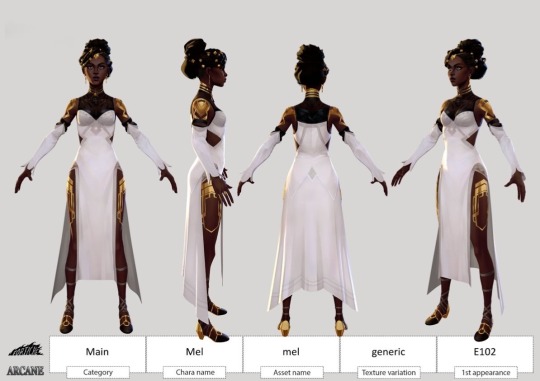


Something regal, a bit form fitting to emphasise her lean and tall silhouette. (Sadly there aren't many depictions of the few Kandake we know about.)
Then I used Maasai/Kenyan traditional and/or inspired dresses to put something up for her.


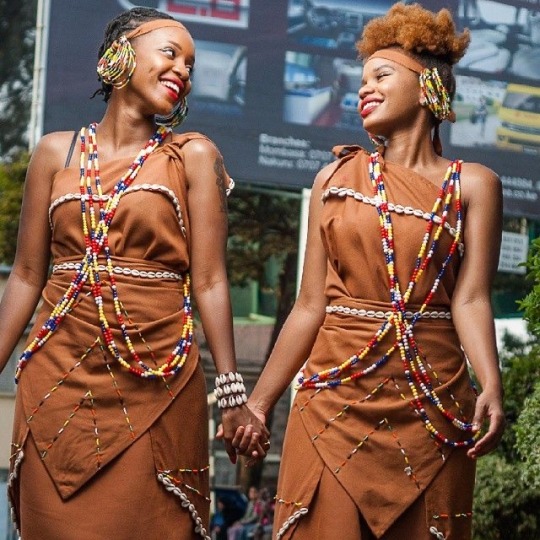
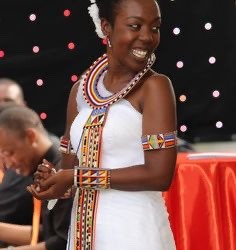
The point was not to be completely accurate though, it's still a modern fantasy world.
One thing about (most) African clothes is that they might seem very simple in making (like the Dera Swahili dresses), and that is because the fabrics used are often very colorful and intricate. Keeping the clothes simple allow the artwork of the fabric to shine. You can find several maps of fabrics online with their names.

For Kinga, the main inspirations were Kandake and Black Panther's Dora Milaje.
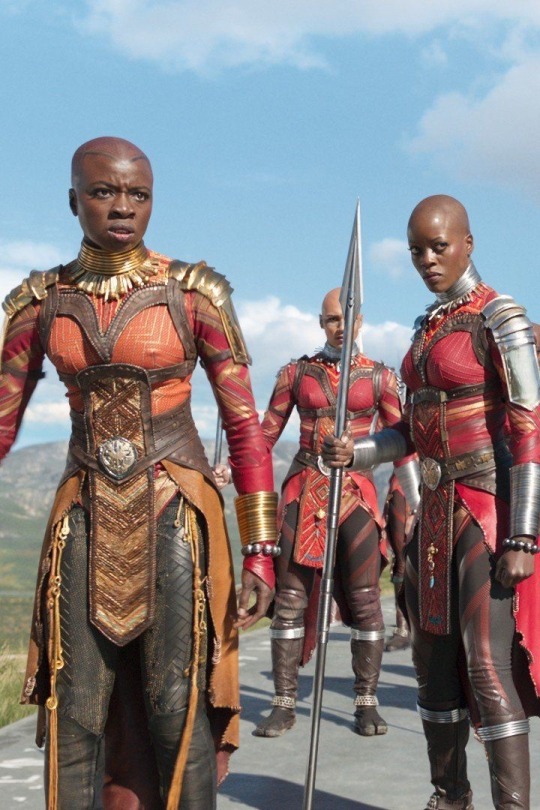
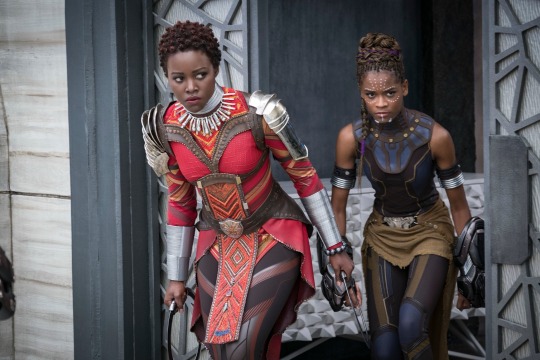
Those are good fighting gears that allow movement while holding everything in place. The costume department did a very good job for those.
I think that is all? Good luck on your OC's making o/ I'm interested to see her if you feel like posting her online!
75 notes
·
View notes
Text
Additional comment from the submitter: ❝ I put on a Dirndl/Tracht from my grandma this morning and immediately knew that I was gonna get some stares bc it's not really a thing around here. But there are more and more ppl, especially African immigrants, wearing their traditional dresses around here and I love that we're slowly moving towards showing off your traditional colours more and more. How is it at your current place and how is it in your culture of origin? I am genuinely curious about your experiences with the topic :) ❞
This poll was submitted to us and we simply posted it so people could vote and discuss their opinions on the matter. If you’d like for us to ask the internet a question for you, feel free to drop the poll of your choice in our inbox and we’ll post them anonymously (for more info, please check our pinned post).
#polls#poll#traditional#culture#tumblr polls#incognito polls#poll time#random polls#tumblr poll#fun polls
36 notes
·
View notes
Note
omg you are also south indian!!!! i find it really hard to find south indians on here, could you do the batboys reacting to reader wearing traditionally indian clothing for a wedding they are attending???
Im north Indian with a little spanish in me shifting to NY actually but yea the indian dc fanfic community is smaller. I love the idea of a traditional indian s/o with Jason particularly. Dick with someone spanish , tim with an African American, Damian with caucasion and bruce with someone asian. Idk why Thats just How I imagine it. Its in no way a canon to their character or a generalization of people from a culture but the cultures ,and norms and values of these cultures really suit the batboys. Hope this isn't offensive. So Im just going to do batboys x reader in a family event .
Batboys(tim, dick, jason , bruce)x y/n - At a family event
Dick Grayson
is also dressed in your cultural's traditional clothes. Dick has traveled all over the world and he likes seeing you in your traditional clothes. Being comfortable in your traditional wear, being in "your element" . He charms up all your family members, no-one even calls him the white boyfriend anymore . The women also hit on him( of all age groups srsly) He is part of the family by the end( or within 5 mins) of the night . Dont be surprised when you find him and your family laughing about what jokes your parents are going to make at your wedding. He isn't even nervous before going. He is a real charmer and you couldn't be prouder.
Jason todd
doesnt want to go. Really thinks your family wont like him and they probably wont the first time they meet him. Will still wear his leather jacket but at least he wore a white shirt and clean jeans? He even agreed to take the car rather then the bike. Will stop complaining the moment he sees you in your element. Like goddess pro max what even , so ethereal ,the world is shaking . Staring dialed up to 100/10 . plus his complaining was never serious to start with. He wants you to have a family, be connected to your background,. Its just one of the things that make you you and he wont change a single hair on you. Will probably get insecure ( I get set up or marriage proposal talks when I go to family functions - just indian girl things I hate it tbh. And I've noticed its a thing in a lot of cultures) because he'll think that you deserve that traditional life with people who 'get you" but no one will ever get you the way he does and you just need to remind him of that. He is a bit broody , tall and just kind of sticks by you . The men and boys of the group are probably fascinated by him so as the night goes he starts getting more comfortable around them. The kids lowkey like him a lot so its cute and you may get baby fever. And the older women of the group are poking at him( why the jacket? whats with that scar) and you'll have to rescue him. He'll do it all over for you though.
Tim drake-
time to put on that practiced facade. He is used to putting on a fake winning smile at those galas so imagine his surprise when his old tricks don't work at your family function. Personal space? privacy?? fake formalities?? don't exist. Bonus points if it isn't a fake rich family. But he gets to see you In a pretty clothes and he is simping, teasing you on how you look like a real girl now(but he lowkey prefers you in the geeky shirts you guys share) . he did research so like ask him the They are still very impressed by your respectful young man ( who is super rich and smart). He gets by tbh, a bit shy because he is just so not used to all this. But keep him near you, show him how to dance properly and get a few drinks in him and its a party. He loves it, your family loves him and your cousins are now his besties (don't ask when that happened). He loves having a family and it just leaves him with wonder. He is in awe of this and so grateful that you let him into your life.
Bruce wayne
does a lot of research . He knows exactly how to act, what to say and what to do. A bit cold and aloof . Still surprised by the whole chaos . But unlike tim he keeps his cool. your family is impressed by you "bagging" the rich billionaire boyfriend. If this is batman with robins ver then they are worried about the huge amount of kids he adopted and what that means for you. So uh..just mention the billion again? They ask really personal questions but bruce prepared and is so ready for it. He loves seeing you in your traditional clothes, probably encourages you to wear them casually too. As if anyone can stop you, go to galas in traditional clothes or just wear home traditional in the mansion. Over all he loves getting a peak into your life and what experiences shaped you to be the woman he loves so dearly now.
If there's anything offensive about this let me know and I will change the content or even delete the whole thing. Ive based it a little of the four different cultured families I have and the common stuff I've noticed in all of them. But I've tried keeping it as general as possible tbh. So I'm sorry if this is offending anyone.
#•#Tim Drake x Reader#Tim Drake x You#Tim Drake x Y/N#Tim Drake Fluff#Tim Drake Angst#Tim Drake Comfort#Tim Drake Headcanons#Tim Drake Imagines#Red Robin x Reader#Red Robin x You#Red Robin x Y/N#Batfamily#Batfamily x Reader#Batfamily Fluff#Batfamily x You#Batfamily x Y/N#Batfamily Headcanons#Batfamily Imagines#Batboys#Batboys x Reader#Batboys Fluff#Batboys Headcanons#Batboys Imagines#Jason Todd + Red Hood#Jason Todd x Reader#Jason Todd x You#Jason Todd x Y/N#Jason Todd Fluff#Jason Todd Angst
110 notes
·
View notes
Text
Male traditions of thievery are found among many peoples. In some South American tribes, the men describe suddenly raiding the women's part of a village and stealing "their things," including string and a flattened stick with which the men made a noisy instrument, a bull-roarer, which they then used to frighten the women. A global mythic tradition of men or boys stealing women's clothing, especially the clothing women leave on the river bank while they bathe, has been suggested by folklorist Martha Beckwith as the theft of menstrual garments. Unless the women gave some of theirs, menstrual blood for sorcery, healing, or magic could be acquired only by stealing. In the West, we might see a fragment of this tradition in college dormitory panty raids!
The male theft of fire, and the sun, is another theme common to myths across a variety of cultures. In a northern Asiatic tradition, Old Grandmother's grandson stole fire from her and burned down the world. Prometheus stole fire from the sun in Greece—from the protomoon, men got the red fire, like blood. In one African myth, the culture hero Mokele "steals" the sun when he goes up a river and discovers the place where the sun lives in a cave. This act of differentiation of the sun surely means he "stole" it from the original protomoon of the female tradition. . . .
Raiding and stealing, always under specific rules, have primarily been men's work, part of men's story. In myths from China to South America, some male characters are thieves who take, not only the paraphernalia of women, but women themselves, queens renowned for their beauty and slaves from other tribes. In addition, they make off with fire, the sun, livestock, treasures, technologies. One effect of this was the accumulation of materials and ideas from many different places, combining and recombining to form mechanical arts and complex trades. Another was the dispersal of "women's stuff" and tribal arts, scattered out from the sacred huts into the secular world. Men, more often than women, have widely dispersed and recombined knowledge, craft, trade, and story.
-Judy Grahn, Blood, Bread, and Roses: How Menstruation Created the World
55 notes
·
View notes
Text
Writing Notes: Ethnocentrism & Cultural Relativism

ETHNOCENTRISM
The tendency to look at the world primarily from the perspective of one’s own culture.
Part of ethnocentrism is the belief that one’s own race, ethnic or cultural group is the most important or that some or all aspects of its culture are superior to those of other groups. Some people will simply call it cultural ignorance.
Often leads to incorrect assumptions about others’ behavior based on your own norms, values, and beliefs.
Example: In extreme cases, a group of individuals may see another culture as wrong or immoral and because of this may try to convert, sometimes forcibly, the group to their own ways of living.
War and genocide could be the devastating result if a group is unwilling to change their ways of living or cultural practices.
Ethnocentrism may not, in some circumstances, be avoidable.
We often have involuntary reactions toward another person or culture’s practices or beliefs but these reactions do not have to result in horrible events such as genocide or war.
In order to avoid conflict over culture practices and beliefs, we must all try to be more culturally relative.
CULTURAL RELATIVISM
The principle of regarding and valuing the practices of a culture from the point of view of that culture and to avoid making hasty judgments.
Cultural relativism tries to counter ethnocentrism by promoting the understanding of cultural practices that are unfamiliar to other cultures such as eating insects, genocides or genital cutting.
Example: Consider the common practice of same-sex friends in India walking in public while holding hands. This is a common behavior and a sign of connectedness between two people. In England, by contrast, holding hands is largely limited to romantically involved couples, and often suggests a sexual relationship. These are simply two different ways of understanding the meaning of holding hands.
Someone who does not take a relativistic view might be tempted to see their own understanding of this behavior as superior and, perhaps, the foreign practice as being immoral.
CULTURAL RELATIVISM: Problems
Despite the fact that cultural relativism promotes the appreciation for cultural differences, it can also be problematic.
At its most extreme, cultural relativism leaves no room for criticism of other cultures, even if certain cultural practices are horrific or harmful.
Many practices have drawn criticism over the years.
Example 1: In Madagascar, the famahidana funeral tradition includes bringing bodies out from tombs once every seven years, wrapping them in cloth, and dancing with them. Some people view this practice disrespectful to the body of the deceased person.
Example 2: Today, a debate rages about the ritual cutting of genitals of girls in several Middle Eastern and African cultures. To a lesser extent, this same debate arises around the circumcision of baby boys in Western hospitals.
When considering harmful cultural traditions, it can be patronizing to use cultural relativism as an excuse for avoiding debate.
To assume that people from other cultures are neither mature enough nor responsible enough to consider criticism from the outside is demeaning.
CROSS-CULTURAL RELATIONSHIP
The idea that people from different cultures can have relationships that acknowledge, respect and begin to understand each other’s diverse lives.
People with different backgrounds can help each other see possibilities that they never thought were there because of limitations, or cultural proscriptions, posed by their own traditions.
Becoming aware of these new possibilities will ultimately change the people who are exposed to the new ideas.
This cross-cultural relationship provides hope that new opportunities will be discovered, but at the same time it is threatening. The threat is that once the relationship occurs, one can no longer claim that any single culture is the absolute truth.
Source ⚜ Writing Notes & References
#writing notes#culture#psychology#writeblr#dark academia#writing reference#spilled ink#studyblr#light academia#literature#writers on tumblr#writing prompt#poetry#poets on tumblr#writing inspo#writing ideas#writing inspiration#creative writing#writing resources
62 notes
·
View notes
Text
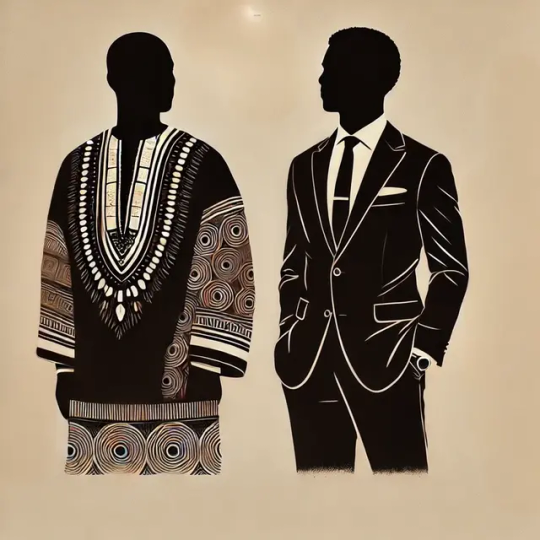
The Difference Between Cultural Identity and Class-Based Behaviour: A Garveyite Perspective on Black Consciousness, Liberation, and Self-Determination
From a Garveyite perspective, which prioritizes Pan-African unity, self-reliance, and the restoration of African/black consciousness, there is a crucial distinction between cultural identity and class-based behaviour that many Black people fail to recognize. This confusion has been intentionally manufactured through colonialism, white supremacy, and capitalist exploitation to keep Black people divided, assimilated, and disconnected from their true heritage.
At its core:
Cultural identity is the collective historical, linguistic, spiritual, and ancestral continuity of a people.
Class-based behaviour is a social construct based on material wealth, economic status, and Western-defined respectability.
This analysis will examine:
Defining Cultural Identity vs. Class-Based Behaviour.
How Colonialism and White Supremacy Engineered This Confusion.
Examples of This Confusion in Black Communities.
Consequences of Mistaking Class for Culture.
The Garveyite Solution: Returning to Pan-African Identity and Self-Determination
1. Defining Cultural Identity vs. Class-Based Behavior
To understand why many Black people confuse the two, we must clearly define them.
Cultural Identity (Rooted in Ancestry & Collective Consciousness)
A people’s shared history, values, traditions, language, spiritual beliefs, and customs.
In the African diaspora, cultural identity is tied to Pan-Africanism, black nationalism, African spirituality, and indigenous traditions.
Remains constant regardless of economic status—it is not defined by wealth or material possessions.
Rooted in African/black philosophy, communal living, and intergenerational knowledge.
Example: Practising African naming traditions, speaking African languages, honouring ancestors, wearing traditional African clothing, and celebrating Black resistance movements are expressions of cultural identity.
Class-Based Behavior (Rooted in Social and Economic Status)
Dictated by income, education level, and Western ideals of success.
Tied to capitalism, assimilation, and Eurocentric concepts of "civilization."
Can change depending on wealth—a person’s social status can rise or fall, but their cultural identity remains.
Enforces Western respectability politics, which dictates how a Black person must dress, speak, and behave to be deemed "successful" in white society.
Example: Some Black elites believe that speaking “proper English,” wearing suits, or getting degrees from Western institutions makes them more cultured—when in reality, these are simply class markers imposed by European systems.
Garveyite Perspective: Black people must recognize that cultural identity is about ancestral roots, Pan-Africanism, and collective liberation—not white validation through social mobility.
2. How Colonialism and White Supremacy Engineered This Confusion
Black people did not naturally develop this confusion—it was imposed on them through slavery, colonial rule, and systemic oppression.
A) Cultural Erasure Under Slavery & Colonialism
African languages were banned, and European tongues were forced upon enslaved Africans.
Indigenous African religions were demonized, and Christianity was imposed to maintain control.
Western education was introduced as the only legitimate form of intelligence.
European clothing and social etiquette were enforced as signs of "civilization."
Tribal and ethnic divisions were created to prevent unity among African peoples.
Example: In the Caribbean, enslaved Africans were deliberately separated from those who spoke the same language to prevent rebellion. In America, Black people were taught that English-speaking, well-dressed house slaves were “superior” to field slaves—creating a false class hierarchy.
B) The Rise of Respectability Politics
After slavery, Black people were pressured to prove their worth to white society by adopting European norms of behavior:
Speaking English "properly" was seen as a sign of intelligence.
Dressing in Western attire (suits, ties, dresses) was deemed respectable.
Christianity was used to reinforce submission, obedience, and assimilation.
Black professionals distanced themselves from poor, working-class Black people.
Example: The Talented Tenth philosophy promoted by W.E.B. Du Bois suggested that a small, highly educated Black elite should lead the race—while Garveyism argued for mass empowerment, economic self-reliance, and a return to African traditions.
Garveyite Perspective: Any ideology that promotes integration into a white supremacist society instead of African self-determination is anti-Black.
3. Examples of This Confusion in Black Communities
Many Black people still mistake economic status and Western respectability for cultural identity. Here are some examples:
A) Language & Speech
Some Black people believe that African-American Vernacular English (AAVE), Patois, Creole, or African languages are “ghetto”, while standard English is “educated.”
In reality, African linguistic structures influence these languages, making them part of our cultural identity.
Example: Many Caribbean and African immigrants are conditioned to believe that abandoning their mother tongues and adopting British or American English is a sign of intelligence, when in fact, this is an example of colonial indoctrination.
B) Clothing & Grooming
Some Black people believe that wearing African/black clothing is “backwards” or “unprofessional”, while wearing a suit and tie makes one respectable.
But a suit and tie is a European standard of dress, not an African or black one.
Example: Black and African clothing that remains uninfluenced by European styles is the kente cloth of Ghana. Woven by the Akan people for centuries, kente is a traditionally handcrafted fabric made from silk and cotton, featuring intricate patterns that hold deep cultural and spiritual significance. It has been worn by Ghanaian royalty and remains a symbol of heritage, status, and pride. Unlike European textiles, kente's designs, colours, and weaving techniques are rooted entirely in African traditions, showcasing a purely indigenous fashion identity.
C) Education & Intelligence
Some believe that having a degree from a Western university makes someone more cultured.
But Western education often promotes anti-Black narratives and European supremacy.
Example: Many Black intellectuals look down on grassroots organizers and Pan-African movements, seeing themselves as superior due to their Western degrees.
Garveyite Perspective: True intelligence is not determined by a degree from Harvard or Oxford—it is measured by self-education, community impact, and Pan-African consciousness.
4. Consequences of Mistaking Class for Culture
This confusion has caused major harm within the Black community:
A) Classism & Division
Black elites often distance themselves from the working class.
Africans and Caribbeans sometimes look down on Black Americans, believing their struggles stem from a lack of "ambition" instead of systemic racism.
Example: African immigrants are often taught that Black Americans are "lazy," when in reality, Black Americans face systemic barriers that prevent economic mobility.
B) Cultural Assimilation & Loss of Identity
Black people abandon African languages, traditions, and values in favour of Western norms.
African spirituality is demonized, while Christianity and Islam remain dominant.
Example: The African American upper class in the 1900s married lighter-skinned partners to gain social status—showing that whiteness, not African identity, was their measure of success.
Garveyite Perspective: Liberation comes through Pan-African unity and cultural reclamation—not integration into white systems.
5. The Solution: Reclaiming a Pan-African Consciousness
To break free from this confusion, Black people must return to authentic Pan-African identity and self-determination.
A) Prioritize African-Centered Education
Learn about African history, languages, and traditions outside of Western institutions.
Stop equating European education with intelligence.
B) Define Success on Our Own Terms
Success is not white approval—it is economic independence, cultural pride, and collective self-reliance.
Stop chasing corporate jobs, luxury brands, and European validation.
Garveyite Perspective: Only through self-sufficiency, cultural pride, and Pan-African unity can Black people truly be free.
Final Thought
Black people must stop confusing class-based Western behaviours with true African/black cultural identity. Only by reclaiming Pan-African consciousness, rejecting respectability politics, and prioritizing self-determination can true liberation be achieved.
---
Tumblr Tags:
#black history#black people#blacktumblr#black tumblr#black#pan africanism#black conscious#africa#black power#black empowering#blog#Garveyism#Garveyite#marcus garvey#class divide#cultural identity#self determination#black liberation#economic empowerment#african heritage#african culture
27 notes
·
View notes